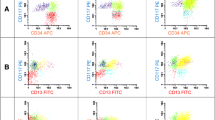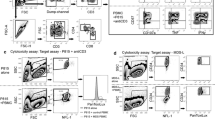Abstract
The cell surface phenotype of immunoregulatory lymphocytes in bone marrow (BM) and peripheral blood (PB) in myelodysplastic syndrome (MDS), a stem cell disorder, was analyzed. Mononuclear cells from 25 patients with refractory anemia (RA) and nine with RA with an excess of blasts (RAEB) were characterized by two-color flow cytometry using various monoclonal antibodies. No significant change of CD3+, CD4+, and CD8+ cells in PB, but a decrease of the percent of positive cells for CD8+ among the total lymphocyte (%CD8+ +) was noticed in RA patients. On the other hand, in BM of RA patients, a decrease in the number of CD4+cells, but not CD8+ +cells, was noted. In RAEB patients, the absolute numbers of CD3+, CD4+, CD8+, and CD8+ +cells in BM were decreased; however, the ratio of these lymphocytes was not changed. No change was observed among the CD4 + subsets in PB of RA or RAEB patients. In BM, a decrease in percentage of CD4+ CD45RA+ (% CD4+ CD45RA+; naive cell) and increases in CD4+ CD45RO+ (% CD4+ CD45RO+; memory cell) and CD4+ CD29+ (%CD4+ CD29+; helper/inducer) among CD4+ cells were found in both RA and RAEB patients. Analysis of the CD8+ + subset showed an increased number of CD8+ + CD11a+ cells (activated CTL) in both BM and PB of RA patients, but not of RAEB patients. Furthermore, increments in CD56+ and CD16+ cells among CD3- cells (natural killer; NK cells) were seen in RA patients but not in RAEB patients. It remains unclear whether lymphocytes in MDS patients were involved in the abnormal (MDS) clones, but our results regarding the increments of CD8+ + CD11a+ and NK cells in RA patients suggest that the mechanism of immune surveillance against the abnormal MDS clones was activated in these RA patients, but not in RAEB patients. Further investigation is required to clarify the functions of these immunoregulatory lymphocytes in MDS patients.
Similar content being viewed by others
References
Akbr AN, Terry L, Timms A, Beverley PCL, Janossy G (1988) Loss of CD45R and gain of UCHL1 reactivity is a feature of primed T cells. J Immunol 140:2171–2178
Amenomori T, Tomonaga M, Yoshida Y, Kuriyama K, Matsuo T, Jinnai I, Ichimaru M, Omiya A, Tsuji Y (1986) Cytogenetic evidence for partially committed myeloid progenitor cell origin of chronic myelomoncytic leukaemia and juvenile chronic myeloid leukaemia: both granulocyte-macrophage precursors and erythroid precursors carry identical maker chromosome. Br J Haematol 64:539–546
Balch CM, Riley LB, Bae YJ, Salmeron MA, Platsoucas CD, Von Eschenbach A, Itoh K (1990) Patterns of human tumor-infiltrating lymphocytes in 120 human cancers. Arch Surg 125:200–205
Baumann MA, Milson TJ, Patrick CW, Libnoch J, Keller R (1986) Immunoregulatory abnormalities in myelodysplastic syndromes. Am J Hematol 22:17–26
Bennett JM, Catovsky D, Danil MT, Flandrin G, Galton DAG, Gralnick HR, Sultan C (1982) Proposals for the classification of the myelodysplastic syndromes. Br J Haematol 51:189–199
Bjorkman PJ, Saper MA, Samraoui B, Bennett WS, Strominger JL, Wiley DC (1987) The foreign antigen binding site and T cell recognition regions of class II histocompatibility antigens. Nature 329:512–518
Bynoe AG, Scott CS, Ford P, Roberts BE (1983) Decreased T helper cells in the myelodysplastic syndromes. Br J Haematol 54:97–102
Culligan DJ, Cachia P, Whittaker J, Jacobs A, Padua RA (1992) Clonal lymphocytes are detectable in only some cases of MDS. Br J Haematol 81:346–352
Damle NK, Mohagheghpour N, Hansen JA, Engleman EG (1983) Alloantigen-specific cytotoxic and suppressor T lymphocytes are derived from phenotypically distinct precursors. J Immunol 131:2296–2300
Economopoulos T, Economidou J, Giannopoulos G, Terzoglou C, Papageorgou E, Devenoulas J, Arseni P, Hadjioannou J, Raptis S (1985) Immune abnormalities in myelodysplastic syndromes. J Clin Pathol 38:908–911
Fontana L, De Sanctis G, De Rossi G, Bottari V, Petti MC, Ensoli F, Pasqualetti D, Mandelli F (1989) Deficiency of lymphocyte lectin-dependent cytotoxicity in myelodysplastic syndromes. Acta Haematol 82:1–6
Gerritsen WR, Donohue J, Bauman J, Jhanwar SC, Kerman NA, Castro-Malaspina H, O'Reilly RJ, Bourhis JH (1992) Clonal analysis of myelodysplastic syndrome: monosomy 7 is expressed in the myeloid lineage, but not in the lymphoid lineage as detected by fluorescent in situ hybridization. Blood 80:217–224
Greenberg PL (1986) Biologic abnormalities in the myelodysplastic syndromes and myeloproliferative disorders. Acta Haematol Jpn 49:1509–1527
Hoelzer D, Ganser A, Heimpel H (1984) “Atypical” leukemias: preleukemia, smoldering leukemia and hypoplastic leukemia. Recent Results Cancer Res 93:69–101
Hokland P, Kerndrup G, Griffin JD, Ellegaard J (1986) Analysis of leukocyte differentiation antigens in blood and bone marrow from preleukemia (refractory anemia) patients using monoclonal antibodies. Blood 67:898–902
Itoh K, Platsoucas CD, Balch CM (1988) Autologous tumor-specific cytotoxic T lymphocytes in the infiltrate of human metastatic melanomas. J Exp Med 168:1419–1441
Jacob MC, Favre M, Lemarc'Hadour F, Satto MF, Bonnefoix T, Satto JJ, Bensa JC (1992) CD45RA expression by CD4 T lymphocytes in tumors invaded by B-cell non-Hodgkin's lymphoma (NHL) or Hodgkin's disease (HD). Am J Hematol 39:45–51
Jacobs A (1985) Myelodysplastic syndromes: pathogenesis, functional abnormalities and clinical implications. J Clin Pathol 38:1201–1217
Janssen JWG, Buscle M, Layton M, Drexler HG, Lyons J, Van den Bergh H, Heimpel H, Kubanek B, Kleihauer E, Mufti GJ, Bartram CR (1989) Clonal analysis of myelodysplastic syndromes: evidence of multipotent stem cell origin. Blood 73:248–254
Kerndrup G, Meyer K, Ellegaard J, Hokland P (1984) Natural killer (NK)-cell activity and antibody-dependent cellular cytotoxicity (ADCC) in primary preleukemic syndrome. Leuk Res 8:239–247
Kibbelaar RE, Van Kamp H, Dreef EJ, De Groot-Swings G, Kluin-Nelemans JC, Beverstock GC, Fibbe WE, Kluin PM (1992) Combined immunophenotyping and DNA in situ hybridization to study lineage involvement in patients with myelodysplastic syndromes. Blood 79:1823–1829
Koeffler HP (1986) Myelodysplastic syndromes (preleukemia). Semin Hematol 23:284–299
Koide J, Engleman EG (1990) Differences in surface phenotype and mechanism of action between alloantigen-specific CD8+, cytotoxic and suppressor T cell clones. J Immunol 144:32–40
Lawrence HJ, Broudy VC, Magenis RE, Olson S, Tomar D, Barton S, Fitchen JH, Bagby GC (1987) Cytogenetic evidence for involvement of B lymphocytes in acquired idiopathic sideroblastic anemias. Blood 70:1003–1005
Lotzova E, Ades EW (1989) Natural killer cells: definition, heterogeneity, lytic mechanism, functions and clinical application. Nat Immun Cell Growth Regul 8:1–9
Lowin B, Hahne M, Mattmann C, Tschopp J (1994) Cytolytic T-cell cytotoxicity is mediated through perform and Fas lytic pathways. Nature 370 650–652
Morimoto C, Letvin NL, Boyd AW, Hagen M, Brown HM, Kornacki MM, Schlossman SF (1985) The isolation and characterization of the human helper inducer T cell subset. J Immunol 134:3762–3769
Morimoto C, Rudd CE, Letvin NL, Schlossman SF (1987) A novel epitope of the LFA-1 antigen which can distinguish killer effector and suppressor cells in human CD8 cells. Nature 330:479–482
Morimoto C, Steinberg AD, Letvin NL, Hagen M, Takeuchi T, Daley J, Levine H, Schlossman SF (1987) A defect of immunoregulatory T cell subsets in systemic lupus erythematosus patients demonstrated with anti-2H4 antibody. J Clin Invest 79:762–768
Mufti GJ, Galton DAG (1986) Myelodysplastic syndromes: natural history and features of prognostic importance. Clin Haematol 15:953–971
Mufti GJ, Figes A, Hamblin TJ, Oscier DG, Copplestone JA (1986) Immunological abnormalities in myelodysplastic syndromes. I. Serum immunoglobulins and autoantibodies. Br J Haematol 63:143–147
Okabe M, Minagawa T, Nakane A, Sakurada K, Miyazaki T (1986) Impaired α-interferon production and natural killer activity in blood mononuclear cells in myelodysplastic syndromes. Scand J Haematol 37:111–117
Perussia B, Fanning V, Trinchieri G (1983) A human NK and T cell subset shares with cytotoxic T cells expression of the antigen recognized by antibody OKT8. J Immunol 131:223–231
Porzsolt F, Heimpel H (1982) Impaired T-cell and NK-cell function in patients with preleukemia. Blut 45:243–248
Rosenberg SA, Spiess P, Lafreniere R (1986) A new approach to the adoptive immunotherapy of cancer with tumor-infiltrating lymphocytes. Science 233:1318–1321
Sanders ME, Makgoba MW, Shaw S (1988) Human naive and memory T cells: reinterpretation of helper-inducer and suppressor-inducer subsets. Immunol Today 9:195–199
Smith SH, Brown MH, Rowe D, Callard RE, Beverley PCL (1986) Functional subsets of human helper-inducer cells defined by a new monoclonal antibody, UCHL1. Immunology 58:63–70
Suda T, Nagata S (1994) Purification and characterization of the Fas-ligand that induces apoptosis. J Exp Med 179:873–879
Symeonidis A, Kourakli A, Katevas P, Perraki M, Tiniakou M, Matsouka P, Georgoulias V, Zoumbos N (1991) Immune function parameters at diagnosis in patients with myelodysplastic syndromes: correlation with the FAB classification and prognosis. Eur J Haematol 47:277–281
Takeuchi T, Tanaka S, Steinberg AD, Matsuyama T, Daley J, Schlossman SF, Morimoto C (1988) Defective expression of the 2H4 molecule after autologous mixed-lymphocyte reaction activation in systemic lupus erythematosus patients. J Clin Invest 82:1288–1294
Yoshida Y (1987) Biology of myelodysplastic syndromes. Int J Cell Cloning 5:356–375
Author information
Authors and Affiliations
Rights and permissions
About this article
Cite this article
Iwase, O., Aizawa, S., Kuriyama, Y. et al. Analysis of bone marrow and peripheral blood immunoregulatory lymphocytes in patients with myelodysplastic syndrome. Ann Hematol 71, 293–299 (1995). https://doi.org/10.1007/BF01697982
Accepted:
Issue Date:
DOI: https://doi.org/10.1007/BF01697982




